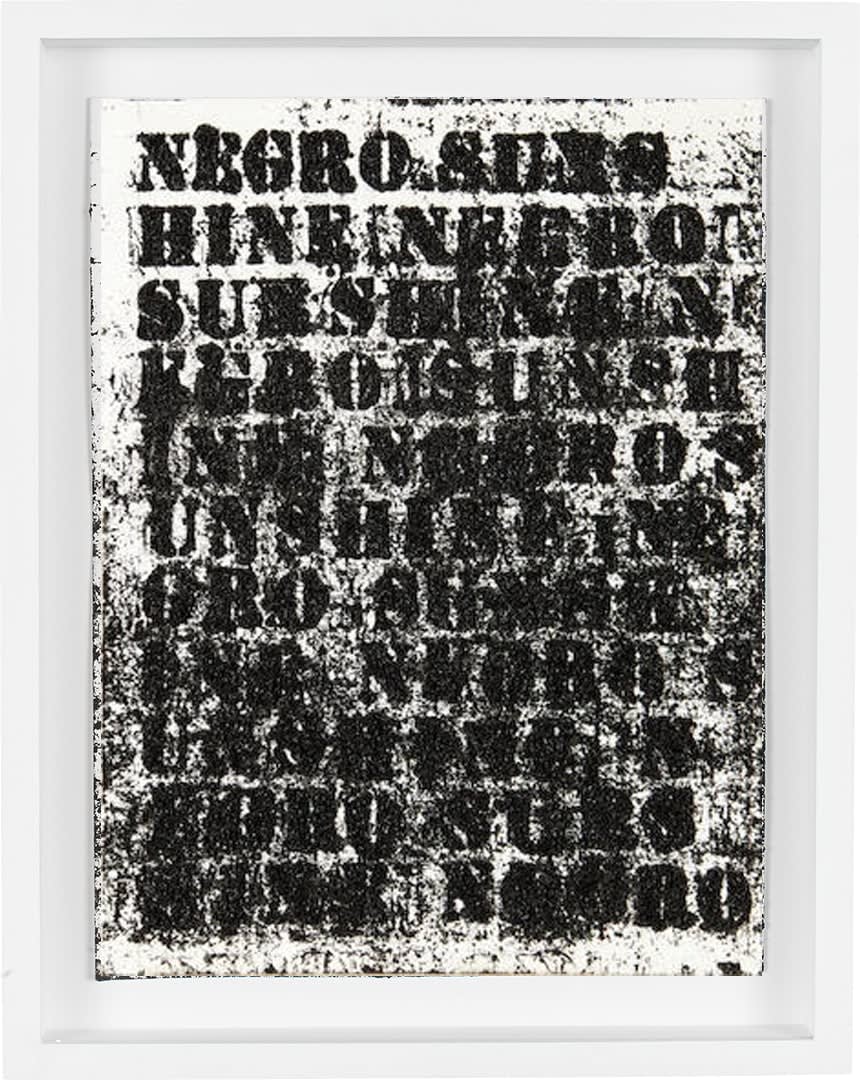Glenn Ligon USA, b. 1960
Study for Negro Sunshine II, #76, 2011
Oilstick, coal dust and gesso on paper
12 x 9 x 2 in
30.5 x 22.9 x 5.1 cm
30.5 x 22.9 x 5.1 cm
7582
Glenn Ligon is known for his multi-media art practice that frequently utilizes text as a way to create intertextual encounters between viewers and the work. He has mobilized the phrase...
Glenn Ligon is known for his multi-media art practice that frequently utilizes text as a way to create intertextual encounters between viewers and the work. He has mobilized the phrase "negro sunshine" different times in his practice. In 2005, he created his first neon piece, called "Warm Broad Glow." The work spelled out the phrase negro sunshine in yellow neon, with the front of the bulbs painted black. Study for negro Sunshine II, #31 (2011) comes from a series of prints in which the phrase is repeated over and over again in various textures and densities. Repetition is important to the work, as the phrase itself comes from the book "Three Lives by Gertrude Stein. The author invokes the enigmatic phrase repeatedly throughout the book as if it were a common aphorism, which it was not. Stein seems to have invented the phrase herself, as a kind of catch-all reference to the supposed laid-back, mellow countenance of African Americans post-slavery. The phrase suggests many racist generalizations, such as being easy going and relaxed, slow moving and pleasant, which were created as a way for White Americans to diminish post-slavery Black Americans by making them seem simple and harmless. Ligon seems to be confronting this slander by forcing us to ask what the phrase means, and in fact whether it has any meaning at all in the various contexts in which he presents it.
Artist Biography:
(From the artist's website)
Glenn Ligon (b. 1960) is an artist living and working in New York. Through his work he pursues an incisive exploration of American history, literature, and society across a body of work that builds critically on the legacies of modern painting and more recent conceptual art. He is best known for his text-based paintings, made since the late 1980s, which draw on the writings and speech of diverse figures including Jean Genet, Zora Neale Hurston, Gertrude Stein and Richard Pryor. He received a Bachelor of Arts from Wesleyan University and attended the Whitney Museum Independent Study Program. In 2011 the Whitney Museum of American Art held a mid-career retrospective of Ligon’s work, Glenn Ligon: America, organized by Scott Rothkopf, that traveled nationally. Important recent shows include Glenn Ligon: Encounters and Collisions (2015), a curatorial project organized with Nottingham Contemporary and Tate Liverpool, and Blue Black (2017), an exhibition Ligon curated at the Pulitzer Arts Foundation in St. Louis, inspired by the site-specific Ellsworth Kelly wall. Ligon has also been the subject of solo museum exhibitions at the Camden Arts Centre in London, the Power Plant in Toronto, the Walker Art Center in Minneapolis, and the Studio Museum in Harlem, among others. His work has been included in major international exhibitions, including the Venice Biennale (2015 and 1997), Berlin Biennal (2014), Istanbul Biennal (2011), Documenta XI (2002), and Gwangju Biennale (2000).
"Rose Johnson was a real black negress. Rose laughed when she was happy but she had not the wide abandoned laughter that makes the warm broad glow of negro sunshine. Rose was never joyous with the earth-born, boundless joy of negroes. Hers was just ordinary, any sort of woman laughter." -Gertrude Stein, from the novella Melanctha in Three Lives, 1909
Artist Biography:
(From the artist's website)
Glenn Ligon (b. 1960) is an artist living and working in New York. Through his work he pursues an incisive exploration of American history, literature, and society across a body of work that builds critically on the legacies of modern painting and more recent conceptual art. He is best known for his text-based paintings, made since the late 1980s, which draw on the writings and speech of diverse figures including Jean Genet, Zora Neale Hurston, Gertrude Stein and Richard Pryor. He received a Bachelor of Arts from Wesleyan University and attended the Whitney Museum Independent Study Program. In 2011 the Whitney Museum of American Art held a mid-career retrospective of Ligon’s work, Glenn Ligon: America, organized by Scott Rothkopf, that traveled nationally. Important recent shows include Glenn Ligon: Encounters and Collisions (2015), a curatorial project organized with Nottingham Contemporary and Tate Liverpool, and Blue Black (2017), an exhibition Ligon curated at the Pulitzer Arts Foundation in St. Louis, inspired by the site-specific Ellsworth Kelly wall. Ligon has also been the subject of solo museum exhibitions at the Camden Arts Centre in London, the Power Plant in Toronto, the Walker Art Center in Minneapolis, and the Studio Museum in Harlem, among others. His work has been included in major international exhibitions, including the Venice Biennale (2015 and 1997), Berlin Biennal (2014), Istanbul Biennal (2011), Documenta XI (2002), and Gwangju Biennale (2000).
"Rose Johnson was a real black negress. Rose laughed when she was happy but she had not the wide abandoned laughter that makes the warm broad glow of negro sunshine. Rose was never joyous with the earth-born, boundless joy of negroes. Hers was just ordinary, any sort of woman laughter." -Gertrude Stein, from the novella Melanctha in Three Lives, 1909
Provenance
Salon 94, New York, 2011Kavi Gupta Gallery
